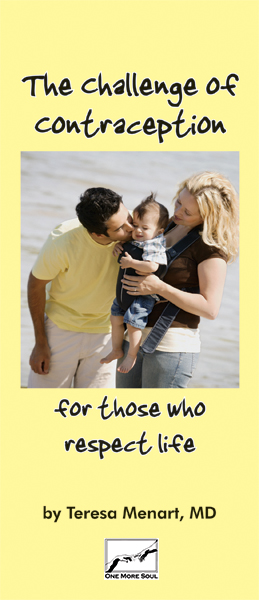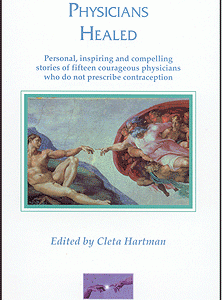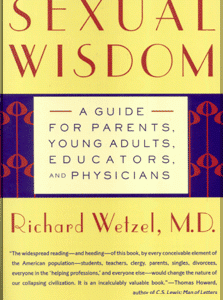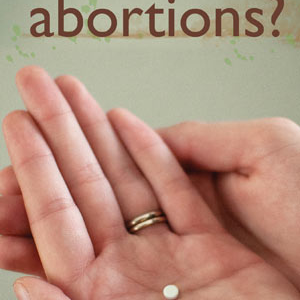Contraception poses a challenge to those who respect life. It may not be immediately obvious that there is any connection between contraception and abortion, but on further examination, a relationship between the two becomes apparent. Ignoring the issue of contraception leads to a lost opportunity to respect life to the fullest degree. There are at least three connections between contraception and abortion to consider:
- Many contraceptives can directly cause early abortions.
- Contraceptive use creates a perceived need for abortion as a “back-up.”
- Contraceptive use causes a devaluation of human life.
We’ll explore each of these ideas in the sections that follow.
Q. Can contraception actually cause early abortion?
Yes. Let’s first consider the birth control pill, the most popular contraceptive used today.1 It has three ways of working.2 Its primary mechanism is to suppress ovulation, but this sometimes fails.3,4 The second is to change the characteristics of cervical mucus, reducing the ability of the sperm to reach and fertilize the ovum. Natural family planning research confirms that cervical mucus is an important factor in fertility.5,6 Thirdly, the lining of the uterus is thinned, making it difficult for the fertilized ovum to implant. So if the first two mechanisms fail, and conception occurs, the new life might just pass through the uterus and be lost with vaginal secretions.
If this last mechanism were the only one working, we would clearly have an abortifacient on our hands. It is difficult to determine how often this third mechanism comes into play when it is one of three possibilities. There have been some attempts to calculate the number of early abortions from birth control pills based on the breakthrough ovulation rate estimated at 2-10%.7 However, these calculations neglect the effects of cervical mucus and require an estimation of the frequency of fertilization.
Another way to approach the problem is to look at the 3% pregnancy rate of birth control pill users.8 In these cases, all three mechanisms fail and a viable embryo is implanted. It is likely then, that even more often an egg is fertilized without surviving the harsh uterine environment, dying by early abortion (lack of implantation). It is impossible to prove the degree to which hormonal contraceptives cause early abortions, but most likely many more embryos are aborted than those who survive to become part of the 3% birth control pill fail rate statistic.
Other hormonal contraceptives (e.g. Norplant and Depo-Provera) have the same effect on the uterine lining, and are open to an even higher risk of early abortion because of a much higher breakthrough ovulation rate.9
It should be noted that the “morning after pill,” or emergency post-coital contraception, is nothing more than a series of birth control pills. Although this regimen may have multiple effects, it is generally accepted that it works because its effects on the uterine lining inhibit implantation.10
There is some debate about the effects of the IUD,11 but at least two of its actions, and probably its principal ones, are to interfere with implantation and with the enzymatic processes of the developing blastocyst. These mechanisms are strictly abortifacient. The possibility has been raised in more recent years that the IUD may also interfere with fertilization.
All of the above contraceptives can end a life already begun.
Q. But what if contraceptives did not cause abortion or one only used barrier methods (condoms and diaphragms) – would there still be a conflict with respect for life?
Yes. Contraceptive use completely changes one’s mentality about sexual relationships. It is the availability of effective contraceptives that has paved the way for the sexual revolution.12,13 Before contraceptives, fear of pregnancy prevented many people from engaging in premarital or extramarital sexual relations. Being ready to engage in a sexual relationship meant being ready to raise children. But contraceptives allow for recreational sex. Couples expect to be able to engage in sexual activity without having to think about the natural result: pregnancy. So when a pregnancy does occur, the child is unwelcome, and abortion is “needed.” In fact, the Supreme Court made manifest this connection in Planned Parenthood v. Casey, when it stated, “in some critical respects abortion is of the same character as the decision to use contraception…for two decades…people have organized intimate relationships and made choices … in reliance on the availability of abortion in the event that contraception should fail.”14 Contraception launches people on a lifestyle which makes abortion more likely, not less likely, to be chosen.
Q. So perhaps we need more effective, non-abortifacient contraceptives. Would this solve the problem?
Even if there were contraceptives that did not cause abortion and were 100% effective at preventing pregnancy, their use would not be compatible with respect for human life. Their very use is against life: “contraception.” They allow a devaluation of human life by stripping the life-giving power away from the sexual act. Sex can then become a meaningless game, rather than the profound mystery that arises out of the deep unity of the couple permanently committed to each other, sharing in God’s power to create new life.
Contraception turns the sexual act against life, against the very power that makes it so meaningful. By changing the nature of the sexual act, it also changes the relationship of the couple involved. A person’s fertility is an integral part of his/her humanity. By holding back their fertility from each other, the couple dehumanizes themselves and each other, and their relationship.15 It becomes very easy for them to simply use each other for their own pleasure. This is a terrible degradation of their own humanity and something most of us instinctively rebel against. It is no surprise, then, that when people learn to degrade and devalue themselves, their loved one, and their relationship, that it becomes easy to devalue the new life that comes forth from them. Abortion becomes a more likely choice when people have been reduced to the level of objects.
Our society today seems to be saturated with the notion that children are now burdens instead of blessings! This is a contraceptive attitude, and it is this very attitude that makes abortion thinkable.
For more information on contraception, or the life-affirming choice of Natural Family Planning, contact One More Soul.
Dr. Menart is a part-time physician of internal medicine, and a full-time mother. She was a OMS Trustee for 4 years.
For more information on Natural Family Planning contact:
Billings Ovulation Method Assn.
www.boma-usa.org (888) 637-6371
The Couple to Couple League
www.ccli.org (800) 745-8252
Family of the Americas Foundation
www.familyplanning.net (800) 443-3395
FertilityCareCenters of America
www.fertilitycare.org (402) 390-6600, ext.117
Institute for Natural Family Planning
www.mu.edu/nursing/NFP (414) 288-3854
Marquette Model
www.marquette.edu/nursing/natural-family-planning/model.shtml (414) 288-3854
Natural Family Planning International
www.nfpandmore.org (740) 457-9663
Northwest Family Services
http://www.nwfs.org/couples-a-singles/natural-family-planning.html (503) 215-6377
One More Soul NFP Center
www.OneMoreSoul.com (800) 307-7685
United States Conference of Catholic Bishops
http://www.usccb.org/issues-and-action/marriage-and-family/natural-family-planning/ (202) 541-3040
References:
1. Guttmacher Institute. Facts on Contraceptive Use January 2008. Retrieved from www.guttmacher.org/ pubs/fb_contr_use.html. Sept. 1, 2009.
2. Physician’s Desk Reference, 52nd ed. (Montvale, NJ, 1998).
3. Kuhar, B. “Infant Homicides through Contraceptives” (Bardstown, KY, 1995) pp. 26-27.
4. * Alcorn, R. Does the Birth Control Pill Cause Abortions? (Gresham, OR, 2007) pp. 21-24.
5. Odeblad, E. “The Biophysical Properties of the Cervical-Vaginal Secretions,” Human Life Center, (Collegeville, MN) 1983.
6. Billings, JJ. “Cervical Mucus, the Biological Marker of Fertility and Infertility,” International Journal of Fertility, 1981; 26:182-195.
7. Kuhar, pp. 26-27.
8. Hatcher, p. 227.
9. Kuhar, pp. 28-29.
10. Hatcher, p. 416.
11. Kuhar, pp. 20-22.
12. Smith, J. “The Connection Between Contraception and Abortion,” Homiletic and Pastoral Review, April 1993.
13. Laumann EO, Michael RT (eds). Sex, Love and Health in America: Private Choices and Public Policies. 2001; 46-49.
14. Smith, J. “The Connection Between Contraception and Abortion,” Homiletic and Pastoral Review, April 1993.
15. *Hogan, R. and Levoir, J. Covenant of Love (New York, 1985) pp. 54-56.
*References 4 and 15 are available from One More Soul.
The Challenge of Contraception for those who respect life
A physician urges pro-lifers to work against contraception.







